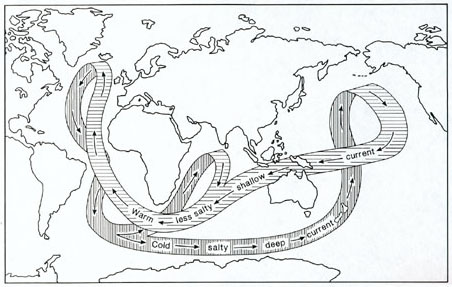Deep-water masses account for more than 90 percent of the total volume of the oceans. Although very few humans will get to see or sample these water masses, they are crucial to the way the ocean works, and key to the properties and behavior of the surface ocean, including much of the marine food chain.
The deep ocean is generally considered to include the ocean below a transition known as the thermocline. The thermocline is the sharp temperature decrease that lies at the base of the surface mixed layer where waters are generally uniform in temperature as a result of convection. Deep-water masses are produced at the surface of the ocean and transported to depth via downwelling. Generally, downwelling occurs where the surface ocean is warm, or, rarely, unusually saline. Downwelling water travels along lines of equal density known as isopycnals and spreads out horizontally at the level where it is equal in density to the surrounding water mass.
The production of deep-water masses via downwelling occurs in high-latitude regions of the northern and southern hemisphere where the surface ocean is cooled by winds. Wind moving over the water both cools it and causes an increase in evaporation. This evaporation targets just the water molecules, resulting in an increase in the salinity of the water. Falling temperature and increasing salinity render these surface water masses denser, allowing them to downwell. In certain locations, the formation of sea ice also causes an increase in salinity as the freezing removes fresh water, leaving the salt behind in a process known as brine exclusion. Pockets of salty water around the margins of the ice sink as a result of their higher density. Moreover, brine exclusion intensifies the cooling by wind.
Map showing formation of North Atlantic Deep Water in the northern part of the North Atlantic
Formation of North Atlantic Deep Water in the northern part of the North Atlantic.
Credit: Darin Toohey (Toohey@colorado.edu)
Today there are three major deep ocean masses. North Atlantic Deep Water or NADW is mainly produced where the surface ocean is cooled in the Norwegian Sea in the northern part of the North Atlantic on the north side of a ridge that runs between Greenland, Iceland and Scotland. This cooled water seeps through the ridge and downwells. Portions of NADW are also produced in the Labrador Sea and in the Mediterranean. This water mass is 1-2.5oC and 35 ppt. NADW travels down the west side of the North Atlantic Ocean at a depth of 2000-4000m and through the west side of the South Atlantic. Much of NADW upwells in the Southern Ocean, but portions join the Antarctic Circumpolar Current and travel at depth into the Indian and Pacific Oceans.
Antarctic Bottom Water or AABW is produced by evaporative cooling off the coast of Antarctica and under the Ross ice shelf. With this source, AABW is amongst the coldest water in the ocean with a temperature of -0.4oC. This water is relatively fresh (average 34.6 ppt). AABW travels northward along the western side of the South Atlantic underneath NADW. Some of the water mass spills over into the eastern part of the South Atlantic, while the remainder travels into the equatorial channel between South America and Africa.
The third major source of deep water is called Antarctic Intermediate Water or AIW. AIW is produced near the Antarctic Convergence or Polar Front where downwelling occurs as a result of convergence of surface currents. AIW has a temperature of 3-7oC and a salinity of 34.3 ppt. It travels a considerable distance northward into the Atlantic, Indian and Pacific Ocean basins.
...
There are numerous other deep water masses, especially at intermediate depths, for example, North Pacific Intermediate water. As deep-water masses travel through the ocean they gradually mix with surrounding water masses. For example, NADW mixes with AABW and AIW.
Downwelling supplies oxygen to the deep ocean and therefore ventilates this body of water. It does not bring nutrients. Deep water currents generally move very slowly with a velocity of several cm per second. Typically, surface currents move 10-100 times faster than this. At these rates deep water currents take thousands of years to encircle the globe. In fact, the oldest deep water in the ocean (in the North Pacific) is about 1500 years old. As deep waters circle the globe their properties change. They mix with waters around them, and their chemistry changes as they acquire nutrients such as phosphate and CO2 from decaying organic matter and lose oxygen.
The opposite process of downwelling is upwelling. Upwelling is where a deep-water mass that is lighter than waters around it rises to the level where it is no longer buoyant. This situation generally results when surface winds move the surface water masses away from a location, resulting in the upward movement of water from depth to fill the void. Upwelling is frequent in coastal regions, especially those in subtropical regions where high pressure results in a dominant offshore wind flow. In addition, the ocean divergences where winds move surface current by Ekman transport are frequented by upwelling. Upwelling is crucial to the supply of nutrients to surface water masses, fueling high levels of productivity in the surface ocean. The most prolific fisheries of the world in coastal regions occur in nutrient-rich waters such as Peru and California and are supplied by upwelling.
As we have seen, the circulation of the deep ocean is driven by density differences that arise as a result of temperature and salinity of the different water masses. This type of circulation is known as thermohaline (temperature=thermo; haline=salt or salinity). Strictly speaking, since surface ocean currents are not driven by thermohaline mechanics but by winds and to a much lesser degree, tides, the circulation of the ocean as a whole is often called the meridional overturning circulation. However, we will continue to use the term thermohaline when addressing deep-water circulation.






